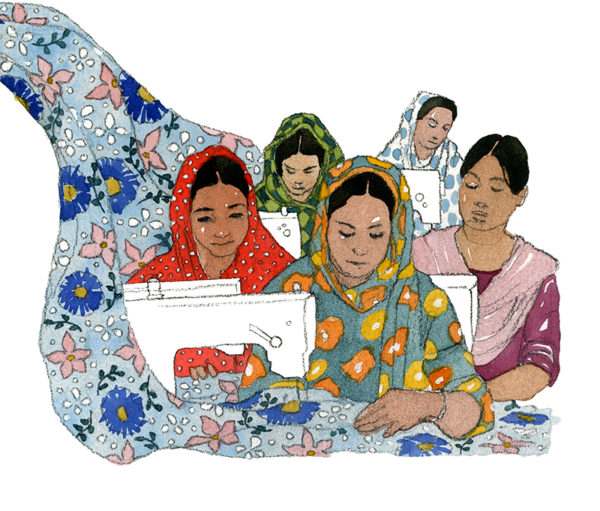 In 2013, dozens of American and European fashion firms were producing garments at the Rana Plaza factory in Bangladesh when it collapsed, killing more than 1,100 workers and injuring 2,500. The building had not been designed or permitted to house a factory, and management had ignored large cracks that had appeared in the walls the previous day.
In 2013, dozens of American and European fashion firms were producing garments at the Rana Plaza factory in Bangladesh when it collapsed, killing more than 1,100 workers and injuring 2,500. The building had not been designed or permitted to house a factory, and management had ignored large cracks that had appeared in the walls the previous day.
In the five years since, the global reaction resulted in the rectification of 97,000 safety hazards in 1,600 Bangladeshi factories. Yet protecting workers’ health and safety—not to mention their basic human rights—remains a challenge.
In India, children as young as 8 labor for pennies a day in sweatshops. Cambodian garment workers are scolded for taking bathroom breaks, fired for getting pregnant, and beaten or shot by police when they organize protests for higher wages.
Elizabeth Pulos, International Trade and Marketing for the Fashion Industries ’15, an associate manager of social compliance at Macy’s, says the ongoing migrant and refugee crises have contributed to a surge in forced labor and human trafficking, with recruiters holding workers hostage by seizing their passports and garnishing their wages. In some countries, the government itself is the problem: Uzbekistan and Turkmenistan, for example, force citizens to work in their countries’ cotton fields, harvesting plants that eventually enter the global supply chain.
According to Shireen Musa, an assistant professor of International Trade and Marketing who teaches international corporate responsibility and wrote her doctoral dissertation on sustainable sourcing, the fashion industry helped create this problem. Having invented a market for fast fashion, companies needed to source products more quickly and cheaply, so they looked to developing countries, where low wages, long hours, and poor working conditions are common.
But in recent years, many companies have taken a stand, introducing a variety of measures aimed at protecting workers.
 IMPROVING FACTORY AUDITS
IMPROVING FACTORY AUDITS
According to Pulos, few international standards exist for factory safety. But many brands and retailers now have their own codes of conduct that align with United Nations Sustainable Development Goals—along with in-house departments dedicated to enforcing them.
Verifying the practices of a factory halfway around the world is neither cheap nor easy. Most large corporations pay third-party auditors to conduct inspections, and since these companies deal with many different factories, the expense of regular audits quickly adds up.
It’s costly for factories, too: a single one might contract with scores of apparel companies, forcing managers and workers to meet with several teams of auditors every week. Jason Kibbey, CEO of the Sustainable Apparel Coalition (SAC), a consortium of apparel brands and manufacturers, says the trivial demands of some audits prevent factory owners from investing in meaningful improvements to worker health and safety. The (possibly apocryphal) tale of the “three fire extinguishers” illustrates this: a factory in Bangladesh had three fire extinguishers mounted to a wall, one above the other—each satisfying the height requirement for a different inspection.
Audits aren’t foolproof, either. Many inspections begin and end at the factory, overlooking infractions at farms and mills. Fraud and corruption (keeping multiple sets of books, coaching workers to mislead auditors) are commonplace. And as Andrea Reyes, Global Fashion Management ’12, International Trade and Marketing ’09, points out, workers may be reluctant to tell the truth even when they aren’t afraid of being fired or beaten.
Reyes, who chairs the New York City Fair Trade Coalition (NYCFT), cofounded A. Bernadette, a company that works with female artisans in Uganda to create fair-trade accessories from recycled materials. She sources her goods in a socially responsible manner, visiting her artisans regularly and relying on a trusted local production manager in her absence. But she suspects that her artisans, like apparel workers the world over, would lie to an auditor if she asked them to.
“My artisans are going to say whatever I want them to say, because they don’t want to risk me walking away with my American dollar bills,” she says.
One solution to the problem of ineffective audits, Reyes suggests, is to use inspectors who are embedded in the communities where they work and understand the local culture and conditions. Better Work, a collaboration between the United Nations and the World Bank, takes this approach in order to improve working conditions while boosting competitiveness.
Technology can help as well. Confidential text- messaging hotlines are enabling garment workers to provide honest feedback in the auditing process. Mapping software that shows the location of every factory, mill, and farm involved in the production of a garment is giving companies a clearer look at their supply chains. Remote sensors and blockchain, a secure digital ledger, may one day provide a more reliable view of what’s actually happening on the shop floor.
Kibbey, meanwhile, advocates moving from a pass-fail auditing system to scaled social responsibility assessments that score factories’ performance and offer incentives to improve, such as more business or better pricing.
The Social Labor and Convergence Project, which originated as an offshoot of the SAC, is poised to unveil a uniform auditing questionnaire. Any user will be able to share data, eliminating the need to audit the same factories over and over.
More than 160 manufacturers, retailers, audit firms, and national governments have signed on.
 THE CASE FOR ETHICAL SOURCING
THE CASE FOR ETHICAL SOURCING
The motivation for companies to treat factory workers well isn’t entirely altruistic: Pulos, who co-wrote an e-textbook on business ethics (Good Corporation, Bad Corporation: Corporate Social Responsibility in the Global Economy) with Guillermo Jimenez, associate professor of International Trade and Marketing, says that companies enjoy lower turnover and greater efficiency when they pay attention to fair wages and worker safety.
Also, nonprofits like the Clean Clothes Campaign and the SAC that promote workers’ rights can sway investor and consumer sentiment, as can social media campaigns by fair-trade activists. Companies that behave irresponsibly risk damaging their reputations and, ultimately, their bottom lines. Many companies therefore belong to nonprofit-certifying organizations such as the Fair Trade Federation and the World Fair Trade Organization. Brands pay a premium on Fair Trade products, which funds community projects that improve workers’ lives, explains Bitu Cao Minh, Fashion Design ’04, director of social compliance and human rights at J. Crew. Cao Minh visited a factory in India where workers used the funds to build a grocery store in their village. “This store was not only helping the factory workers, but also the community,” Cao Minh says. “For me, this is a great example of sustainable development and corporate social responsibility done right.”
 SPREADING THE MESSAGE
SPREADING THE MESSAGE
Ultimately, however, the power to help garment workers lies with consumers: The more strongly we support ethically sourced goods, the more socially responsible the industry will become.
That support exists, at least among millennial consumers. According to the Robin Report, a website devoted to retail apparel and related industries founded by former faculty member Robin Lewis, 65 to 70 percent of consumers under 35 around the world say they choose brands or retailers based on their ethical practices. And two thirds of global respondents in a recent Nielsen study said they would pay more for merchandise produced by firms that support social and environmental causes. But brands need to communicate their corporate social responsibility efforts to consumers. To that end, the NYFTC recently formed a committee of fair-trade advocates devoted to education and social media, to help people understand what socially responsible sourcing means, and why it matters—something Reyes tries to accomplish by leading her own fair-trade education trips to Uganda.
 To better inform the public about the importance of ethical sourcing, she and her colleagues in the coalition are asking themselves a deceptively simple question: “How can we use our marketing skills to push this movement forward, grab people’s attention, and make this information known not just to the fashion community, but to everyone?”—Alexander Gelfand
To better inform the public about the importance of ethical sourcing, she and her colleagues in the coalition are asking themselves a deceptively simple question: “How can we use our marketing skills to push this movement forward, grab people’s attention, and make this information known not just to the fashion community, but to everyone?”—Alexander Gelfand
What is our responsibility to overseas garment workers?
In a 1972 essay, “Famine, Affluence, and Morality,” philosopher Peter Singer argued that, just as we have a moral responsibility to save a drowning child, we have a moral responsibility to save lives in other countries. Lucy Collins, assistant professor of Social Sciences, teaches this essay in the Business Ethics course required for all Fashion Business Management and International Trade and Marketing students. “If we were face to face with starving people or endangered factory workers, most people would do what they could to prevent that,” Collins says. “But it’s so far removed—these are places most people will never go. However, the fact that we are not observing it doesn’t change our moral responsibility. My preference for buying clothes does not outweigh someone else’s preference for life.”
—Jonathan Vatner
Originally published in the summer 2018 issue of Hue.
